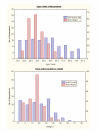Experience of road and other trauma by the opiate dependent patient: a survey report
- PMID: 18454868
- PMCID: PMC2396610
- DOI: 10.1186/1747-597X-3-10
Experience of road and other trauma by the opiate dependent patient: a survey report
Abstract
Background: Trauma plays an important role in the experience of many patients with substance use disorder, but is relatively under-studied particularly in Australia. The present survey examined the lifetime prevalence of various forms of trauma including driving careers in the context of relevant medical conditions.
Methods: A survey was undertaken in a family medicine practice with a special interest in addiction medicine in Brisbane, Australia.
Results: Of 350 patients surveyed, 220 were substance dependent, and 130 were general medical patients. Addicted patients were younger (mean +/- S.D. 33.72 +/- 8.14 vs. 44.24 +/- 16.91 years, P < 0.0001) and had shorter driving histories (15.96 +/- 8.50 vs. 25.54 +/- 15.03 years, P < 0.0001). They had less driving related medical problems (vision, spectacle use, diabetes) but more fractures, surgical operations, dental trauma and assaults. Addicted patients also had significantly worse driving histories on most parameters measured including percent with driving suspensions (O.R. = 7.70, C.I. 4.38-13.63), duration of suspensions (1.71 +/- 3.60 vs. 0.11 +/- 0.31 years, P < 0.0001), number of motor vehicle collisions (2.00 +/- 3.30 vs. 1.10 +/- 1.32, P = 0.01), numbers of cars repaired (1.73 +/- 3.59 vs. 1.08 +/- 1.60, P = 0.042), rear end collisions (O.R. = 1.90, CI 1.13-3.25), running away after car crashes (O.R. = 26.37, CI 4.31-1077.48), other people hospitalized (O.R. = 2.00, C.I. 0.93-4.37, P = 0.037) and people killed (17 vs. 0 P = 0.0005). Upon multivariate analysis group membership was shown to be a significant determinant of both cars repaired and cars hit when controlled for length of driving history. Hence use of all types of drugs (O.R. = 10.07, C.I. 8.80-14.72) was more common in addicted patients as were general (O.R. = 3.64, C.I. 2.99-4.80) and road (O.R.= 2.73, C.I. 2.36-3.15) trauma.
Conclusion: This study shows that despite shorter driving histories, addicted patients have worse driving careers and general trauma experience than the comparison group which is not explained by associated medical conditions. Trauma is relevant to addiction management at both the patient and policy levels. Substance dependence policies which focus largely on prevention of virus transmission likely have too narrow a public health focus, and tend to engender an unrealistically simplistic and trivialized view of the addiction syndrome. Reduction of drug driving and drug related trauma likely require policies which reduce drug use per se, and are not limited to harm reduction measures alone.
Figures




Similar articles
-
The Association between Regional Environmental Factors and Road Trauma Rates: A Geospatial Analysis of 10 Years of Road Traffic Crashes in British Columbia, Canada.PLoS One. 2016 Apr 21;11(4):e0153742. doi: 10.1371/journal.pone.0153742. eCollection 2016. PLoS One. 2016. PMID: 27099930 Free PMC article.
-
Road traffic crashes among farm vehicle drivers in southern China: A cross-sectional survey.Traffic Inj Prev. 2017 Jan 2;18(1):83-87. doi: 10.1080/15389588.2016.1190840. Epub 2016 Jun 3. Traffic Inj Prev. 2017. PMID: 27257936
-
Role of alcohol in hospitalized road trauma in Viet nam.Traffic Inj Prev. 2013;14(4):329-34. doi: 10.1080/15389588.2012.715253. Traffic Inj Prev. 2013. PMID: 23531254
-
[Healthy elderly drivers are more likely to commit errors or lapses than violations. Survey of 904 volunteers].Presse Med. 2006 Jun;35(6 Pt 1):941-7. doi: 10.1016/s0755-4982(06)74725-x. Presse Med. 2006. PMID: 16783251 French.
-
Road traffic accidents and self-reported Portuguese car driver's attitudes, behaviors, and opinions: Are they related?Traffic Inj Prev. 2016 Oct 2;17(7):705-11. doi: 10.1080/15389588.2016.1150591. Epub 2016 Feb 18. Traffic Inj Prev. 2016. PMID: 26889832
Cited by
-
Driving Behaviors in Iran: A Descriptive Study Among Drivers of Mashhad City in 2014.Glob J Health Sci. 2015 Mar 26;7(7 Spec No):39-45. doi: 10.5539/gjhs.v7n7p39. Glob J Health Sci. 2015. PMID: 26153202 Free PMC article.
-
Would You Be Surprised If This Patient Died This Year? Advance Care Planning in Substance Use Disorders.J Gen Intern Med. 2019 Nov;34(11):2630-2633. doi: 10.1007/s11606-019-05223-z. Epub 2019 Aug 5. J Gen Intern Med. 2019. PMID: 31385207 Free PMC article.
-
Successful engagement in buprenorphine treatment among hospitalized patients with opioid use disorder and trauma.Drug Alcohol Depend. 2020 Oct 1;215:108253. doi: 10.1016/j.drugalcdep.2020.108253. Epub 2020 Aug 27. Drug Alcohol Depend. 2020. PMID: 32890919 Free PMC article.
References
-
- NIDCR . Archive: The Oral-Systemic health connection. (NIH ed. pp. ) Bethesda, Maryland: Department of Health and Human Services, USA; 2005. http://www.nidcr.nih.gov/Research/ResearchResults/NewsReleases/ArchivedN...
-
- Looking at the periodontal-systemic disease connection http://www.nidcr.nih.gov/Research/ResearchResults/InterviewsOHR/TIS07200...
-
- Desvarieux M, Demmer RT, Rundek T, Boden-Albala B, Jacobs DR, Jr, Sacco RL, Papapanou PN. Periodontal microbiota and carotid intima-media thickness: the Oral Infections and Vascular Disease Epidemiology Study (INVEST) Circulation. 2005;111:576–582. doi: 10.1161/01.CIR.0000154582.37101.15. - DOI - PMC - PubMed
MeSH terms
LinkOut - more resources
Full Text Sources
Medical

